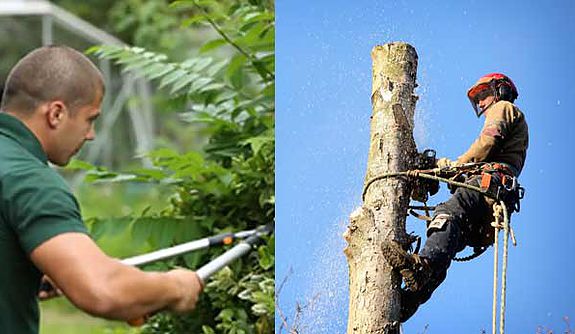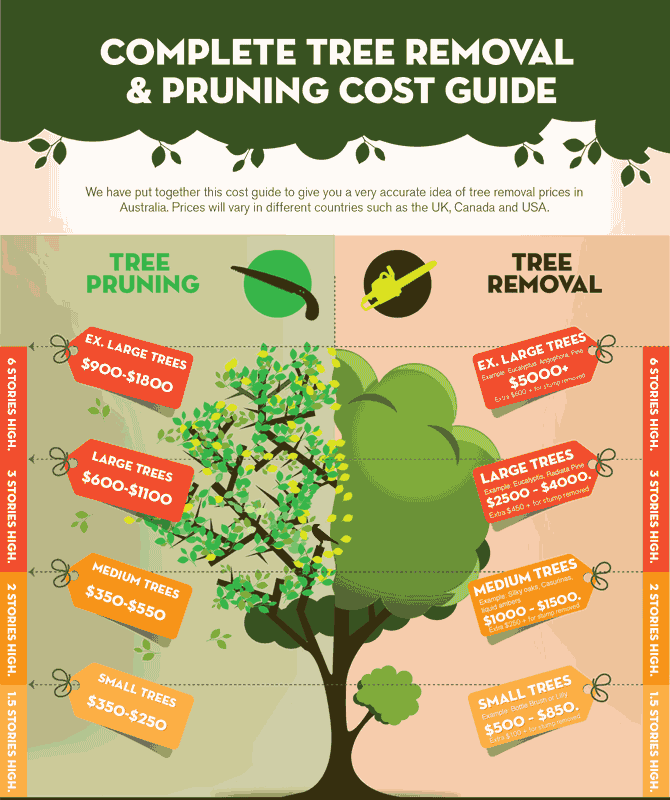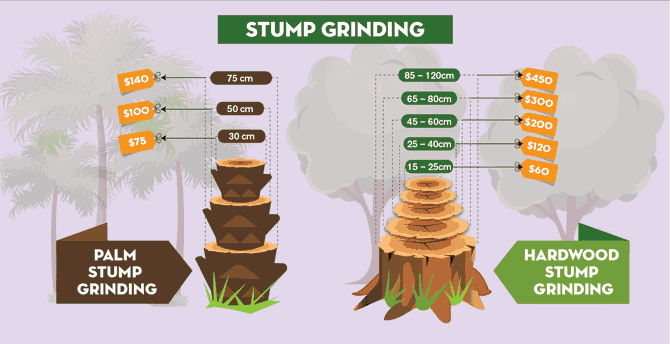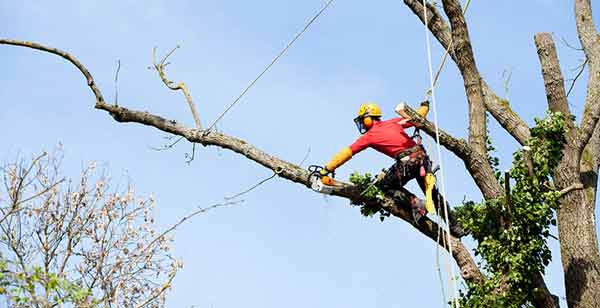The cost to remove a tree ranges from $550 to $22,000, depending on the complexity of the job.
You can use our tree removal cost calculator or request a quote for tree removal from a professional tree removal service to determine much it will cost for your specific scenario.
The cost depends on various factors, including tree size, tree type, and specific circumstances surrounding the condition of the tree, its location of the tree, and accessibility.
In this guide, we’ll help you find out how much your tree removal job will cost by breaking down the various factors that affect tree removal costs.
Whether you’re curious about how much does tree removal cost or much does it cost overall, this article provides a comprehensive price guide to help you cost out your tree removal project.
Table of contents
ToggleProfessional Tree Removal Price by Tree Size
The size of a tree is the number one factor that affects tree removal costs. In fact, the bigger the tree, the more labor and equipment are required, which directly influences the price of removing a tree. Here’s a breakdown:
- $500 – $1,500 for small trees (5 – 6m)
- $1,500 – $3,000 for medium trees (6 – 9m)
- $3,000 – $7,000 for large trees ( 9 – 20m)
- $7,000 – 22,000 for extra large trees (20 – 50m)
Why is tree removal so expensive?
Tree removal is inherently expensive due to several factors:
Equipment Cost & Maintenance: Most local services invest between $100k – $300k in equipment. This includes chainsaws, mulching machines, stump grinders, EWPs, and sometimes even a woodchipper to the tree for processing tree waste.
Insurance: The risk involved means insurance is a huge part of the cost of the tree removal. Workers’ compensation adds roughly 9% on top of wages.
Workers: A minimum of three skilled workers is required even for minor jobs. When different tree removal companies are compared, you may notice that choosing a tree removal company with certified staff can increase the cost due to higher labor rates.
For instance, if you’re wondering how much does tree removal come to, the time and cost of the job will reflect these challenges.
Factors affecting cost
When a tree surgeon comes out to assess the tree, they consider numerous considerations for tree removal. Here are the main factors:
Tree Type/ Tree Species
According to a local tree surgeon we consulted for this article:
“Some trees are just harder to work on than others. A Liquid Amber has very small branches with little spread, while a Gum can be much more time-consuming.”
When we conferred with an arborist in Brisbane, he commended:
“Palms come in all shapes and sizes. An Alexander palm has a skinny trunk with small fronds, whereas a Date Palm has a huge trunk with large branches covered in spikes.” The factors specific to your tree and its species can influence the cost of removal.
Size
This is a big (or small) factor tree removal services take into consideration. The larger the tree is, the more timber there is the remove, which leads to a larger removal price.
- Small – Lill Pilly, Bottle brush, Magnolia, Crepe Myrtle
- Medium – Weeping Willow, Sheoak, Banksia, Silver Birch.
- Large – Red gum, Silky oak, Lemon Scented Gum, Bunya Pine
- Extra Large – Norfolk Island Pine, Moreton Bay Fig, Coastal Black butt
Safety
A sick or dying tree can be very hazardous to remove, as it may be structurally unsound. There are also some species which are notoriously unsafe and dangerous to remove.
So, with unsafe trees comes extra equipment and procedures in an attempt to mitigate all possible hazards. This includes:
- Elevated work platform
- Extra crew members
- Extra safety lines
- Crane-assisted
- Cherry pickups
- Traffic control
- Powerline shutdowns
Dead trees
Dead tree removal is always more expensive than a live tree. The reason being a dead tree is a lot more difficult to work with and may require special equipment such as a cherry picker or crane.
- As a general rule of thumb, you can add 20% – 40% to the prices listed above.
Property Access
How easy it is to access a tree is a crucial factor when an arborist is determining cost. A front yard vs backyard access will cost significantly less compared with poor rear access.
If your tree service is able to get heavy equipment like their truck and chipper close to the base of the tree, this will reduce removal times and cost. If not, extra manpower and time are required to drag branches and logs by hand to the truck. This will cost more.

Terrain
Just like property access, terrain is another factor you should consider. Uneven or sloped terrain can massively complicate waste transport, reduce site accessibility, and require more frequent breaks for the crew.
So, the less accommodating the terrain is, the higher your bill is going to be. And while terrain isn’t the most important factor for cost, it has a huge effect on two of the other factors we talked about – property access and safety.
Emergency Tree Removal Costs
Emergency tree removal is general done at odd hours and is under extremely dangerous circumstances. These types of removal can be very expensive depending on the tree size and the hazard of the situation. For example, if the weather is very windy, or there’s rain, lightning, etc.
- Pro tip: For emergencies, call the SES first. They will make the tree safe and get it off the road, driveway or car, which will give you more time to get a regular price on removal.
Permits to Work
Permit fees can range from $65 to $250, depending on council fees. Tree removal permits are required in a lot of cases for large tree removal. There are circumstances when a permit is not required, but it does vary from council to council.
- See local permit laws in your area here.
Arborist Reports
Some councils will require an independent arborist report before they will grant a permit for removal. For a single tree this will cost $500 on average. Arborist reports do not guarantee a favourable outcome for removal or an automatic permit from council.
Travel Time
Some companies charge travel time if your job is more than 30 minutes from their base of operations. To negate this cost, I suggest you only get quotes from local companies. You have nothing to gain going with a company out of your area.
Time of Year
Tree removal is seasonal so arranging to have a tree removed in the off-season is going to save you an average of 10%. Winter is the best time to get quotes on getting a tree cut down.
Qualifications: Arborists vs Gardners
The prices for removing a tree from a qualified arborist (expert in urban tree management) and the local garden maintenance man are night and day.
- You will require an arborist for anything 5m in height or taller, but if you have a smaller specimen, then I suggest the local lawn and garden care business. It will save you money.
- Arborists generally don’t do small tree trimming and removal or hedging work, so getting a gardener in is slash costs by 50% or more.

Price by City
The median tree removal cost country-wide is approximately $1,740. However, prices can vary depending on the location of the tree removal service. For example:
| City | State | Difference +/- From The Average | Avgerage Cost |
|---|---|---|---|
| Sydney | NSW | + 9.06 % | $2,354 |
| Newcastle | NSW | + 3.74 % | $1,993 |
| Perth | WA | + 1.16 % | $1,763 |
| Brisbane | QLD | + 0.1 % | $1,851 |
| Canberra | ACT | 0 % | $1,740 |
| Gold Coast | QLD | – 1.23 % | $1,648 |
| Melbourne | VIC | – 2.17 % | $2,350 |
| Hobart | TAS | – 6.32 % | $1,643 |
| Adelaide | SA | – 6.72 % | $1,789 |
- The cost variance by city is large with the highest cost of tree removal being 9.06% higher than the countrywide average of $1,740.
- On the low end, the best price in the country for having trees removed at 6.72% less than the average, coming in at $1,623.
The above prices to get a tree removed may vary depending on the company you go with. Additional tree services such as stump removal and mulch spreading can add to the cost.

Extra Expenses
Stump Removal
Stump removal cost is usually included in the quote for tree removal, but not always. Be sure to ask the tree service for a price including stump and root removal. You can expect to pay $70 to $550 for palm stump removal, and $250 to $1,200 for regular/ hardwood tree stump removal.

Disposing of Green Waste
The disposal of tree waste is a cost consideration, especially for palms. A palm tree can not be mulched, so tree service need to pay to dispose of them as general waste at the tip. This adds 50% to the cost of palm removal.
- Pro tip: To get a 50% discount on palm tree removal, ask the service to cut the palm down and stack the logs and frond on the nature strip for council clean up.
Tree Trimming & Pruning

The average cost of tree trimming is $435 which would include trimming 15% of the foliage of an 8m specimen.
Below are some of the biggest factors in the price of tree pruning. These are the factors that makeup trimming costs.
- Height and canopy spread
- The number of branches you need to remove
- Obstacles such as power lines and sheds
- The time take to prune
Cost Calculator for Tree Lopping

Tree Lopping
Note: “lopping” is a very general term given to either removal or pruning. In this guide, we will refer to either specifically removing the whole tree or the pruning of branches.
If you are here researching tree lopping cost, you can get all the information on the removal or you can go to our tree pruning cost guide page for trimming cost info.
Palm Removal
Palm trees are priced differently from normal tree removal. This is because dumping fees need to be added.
- 1 x palm removal 5m high = $350 – $450 (includes tipping fees). Add $270 for each additional.
- 1 x palm removal, 8m high = $450 – $650 (including tipping fees). Add $380 for each additional.
- Palm pruning is normally $150 – $175 each
Note: We have put together a palm removal cost guide for specific species based on their size.
Removing Fallen Tree
These are by far the easiest jobs for an arborist. The hard part of tree removal is felling the tree. As it has already fallen on its own (and hopefully not cause too much damage), it won’t cost you nearly as much to get it cut up and taken away.
- The 10m tree will cost $1,600 – $3,000.
- 15 – 20m will be closer to $2,000 – $5,000, but again you need to consider access.
FAQ's
Insurance will cover the cost of a fallen tree but not a live healthy one. Generally, you have a better chance of getting an insurance company to come to the party if it has fallen and damaged something.
Most local services will not commit to a price over the phone. The reason is that all trees are different. They are hard to describe over the phone or with an image and give an accurate price.
In most cases, the answer is no. There are some palm species that are highly desirable and landscaping companies will come and remove your tree for free as they know they can sell it to other customers, but for 99% of cases, you will need to pay for removal.
You will need to check the tree removal laws for your local council. If the tree is considered significant and is not exempt from the rules, you will need to apply for a permit first.
Normally dead or dangerous trees can be removed without a permit, but anything larger than 5m high will need approval first.
The cheapest time to remove a tree in Australia is typically in late summer to early autumn (February–March). During this period, tree removal services experience less demand compared to peak times like spring and winter when storms or emergencies occur. Scheduling your removal during off-peak times can help save on tree removal costs.
A tree near your house does not automatically require removal. However, if an arborist determines that the tree is diseased, structurally weak, or leaning dangerously, you may need to remove it to protect your property. Signs include large dead branches, cracks in the trunk, and visible root damage. Regular maintenance might be sufficient if the tree is healthy.
Yes, many tree removal companies offer discounts if you schedule the removal of multiple trees in a single visit. Bundling the work can lower the overall cost of the tree removal since the additional time and equipment are shared across the jobs.
A tree should be removed if it exhibits any signs of severe disease, decay, or structural instability. Key indicators include:
Large dead branches or significant leaf loss beyond seasonal shedding
Visible cracks or cavities in the trunk
Fungal growth (like mushrooms) around the base
A sudden or increasing lean
Roots lifting from the ground or causing damage to structures
If you’re unsure, consult an arborist to assess the tree before making a decision.
A tree may be too close if:
It is within 3–5 metres of your foundation (this varies by species).
Large branches overhang your roof, increasing the risk during storms.
Roots are lifting driveways or causing cracks in walls.
Leaves and debris block gutters, leading to water damage.
It’s a species with aggressive root systems (e.g., certain eucalypts and figs).
For trees that are too close, consider regular pruning or installing root barriers. In some cases, you might need to remove your tree entirely.
It depends on whether the roots pose a risk to structures such as pipes or footpaths. If so, it’s best to remove them. Otherwise, leaving them to decompose can enrich the soil naturally. However, dead roots may attract pests like termites or create trip hazards, so professional advice is recommended.











